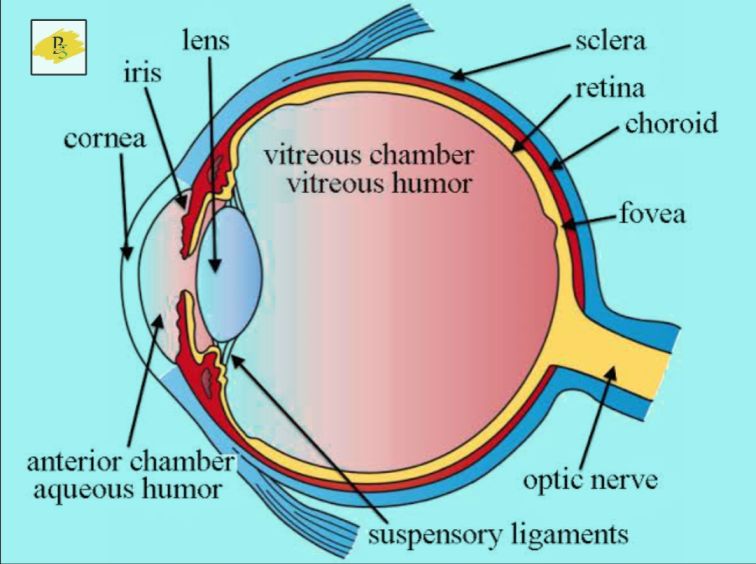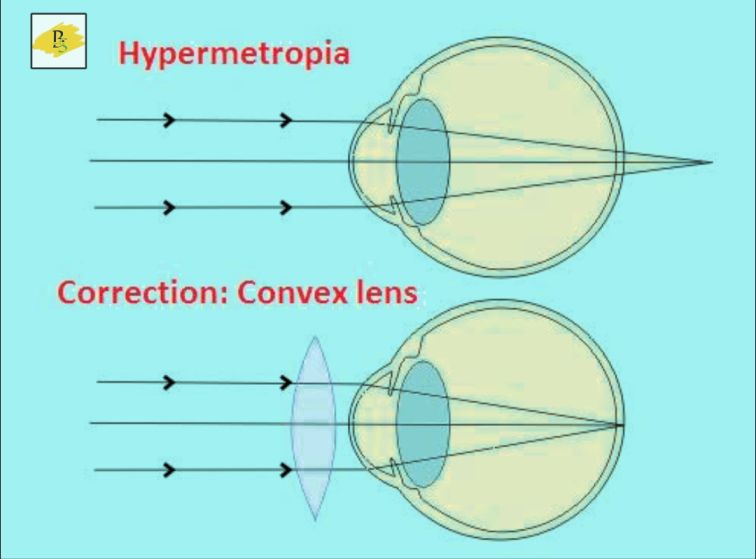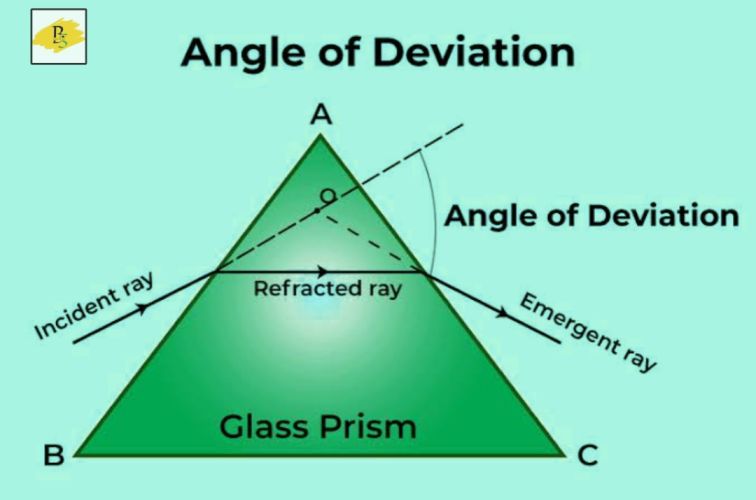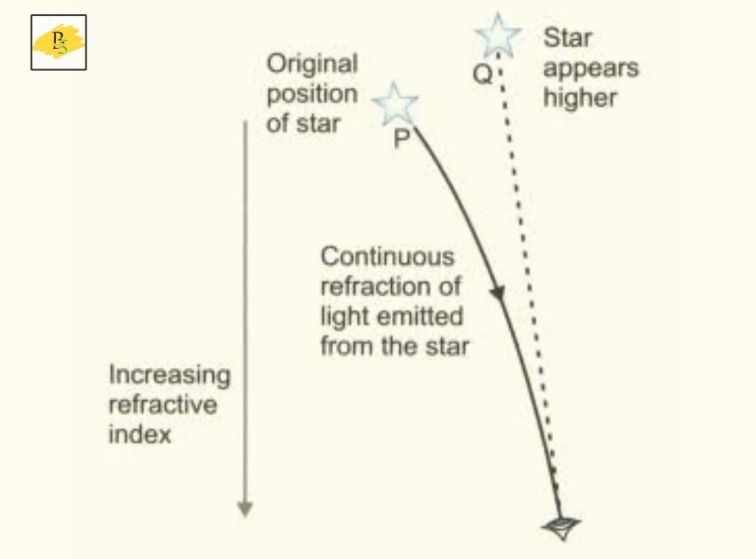The Human Eye and the Colourful World : In this chapter we will understand the functioning of eyes along with certain phenomenon.
The main part of the human eyes are: Cornea, Iris, Pupil, Ciliary Muscles, Eye Lens and Optics Nerves.
Construction of Human Eyes

The eyeball is almost spherical in shape having the diameter of 2.5 cm. The frontal part inside the eye is known as Cornea. It is convex in shape. The light coming from object enter through cornea inside the eye. Just behind the cornea Iris is present. It is flat coloured membrane. Their is hole in the middle of the Iris called Pupil. It appeared black because no light reflect from it.
The eye lens is convex lens made up of transparent, soft and flexible material made up of protein. The eye lens can change the shape to focus light or retina. These eye lens attached to ciliary muscles which change the thickness of eye lens during focusing. The main screen inside the eyes where all the image is formed is called Retina. It is just like a film in camera. The retina is a delicate membrane having a large number of sensitive cell called rods and cons which respond to the intensity of light and colour of the object. At the junction of optic nerves and retina in the eye, there is no light sensitive cells due to which no vision is possible at that point, this is called blind spot. Blind spot is a small area of retina insensitive to light where optic nerves leaves the eye.
The space between cornea and eye lens is filled with a liquid called aqueous humus. The space between eye lens and retina is filled with transparent jelly like substance called Viterous humus which support the back of the eye.
Working of the eyes
The light ray coming from object kept in front of us enter to the cornea of eye pass through pupil and fall on the eye lens. The eye lens is the convex lens so it converge the light rays and produce real and inverted image of object on retina this image is conveyed to the brain by optic nerves and give rise to the sensation of vision. The retina send electrical signal to the brain through optic nerves and our mind interrupt the image as that of erect object.
Function of Iris and Pupil
The Iris control the amount of light entering the eye. Iris automatically adjust the side of the pupil according to the intensity of light received by eye.
Rods and Cones
Rods: These are rod shape cell present in retina of eye which are sensitive to dim light. Owl have large number of rod cell present in their retina which help them to see properly during night when their is not much light.
Cones: These are cone shape cell present in retina of eye which are sensitive to bright light. It cause sensation of colour of object in our eye.
Power of Accommodations
A normal eye can see distant object as well as nearby object clearly by changing the focal length of eye lens it is called power of accommodation.
The Range of Vision of Human Eye
- Far Point: The farthest point from the eye at which an object can be seen clearly is known as far point. The far point of normal human being is infinity.
- Near Point: The nearest point up to which the eye can be seen an object clearly without any strain is called near point of eye. The near point of normal human eye is 25 cm from the eye. Also known as least distance of distinct vision.
Defect of vision and their correction


- Myopia (Short Sightedness): It is a defect of vision due to which a person can not see a distant object clearly, but can see nearby object clearly. The cause of this defect is due to high converging power of eye lens (because of its short focal lenght). And due to eyeball too long. The correction of this defect is by using spectacles containing concave lens.
- Hypermetropia (Long Sightedness): It is the defect of vision due to which a person cannot see nearby object clearly but can see distant object clearly. The cause of the defect is due to low converging power of eye lens (large focal length). And due to eye ball to short. The correction of this defect is by using spectacle containing convex lens.
- Presbyopia: It is the defect of vision due to which an old person can not see nearby object clearly due to loss of power of accommodation of eye. The defect is corrected by using convex lens spectacles.
It is possible that same person may have both defect of vision: Myopia as well as Hypermetropia. It can be corrected by using bifocal lenses in which upper part consist of concave lens (to correct Myopia) used for distant vision and lower part consist of convex lens (to correct hypermetropia) used for reading purpose.
Cataract: The medical condition in which the lens of the eye of a person become cloudy resulting in blurred vision is called cataract. It can be corrected by surgical operation and new artificial lens is inserted in its place.
Key points on Human Eye
- A human being has horizontal fold of view of about of 150 degree with one eye open but with two eyes open it is about 180 degree.
- The human being having two eyes at the front of their head so their field of view is limited to about 180 degree.
- Some animal have their 2 eyes located on opposite side of their head. Those animal who have 2 eyes on opposite side of their head have widest field of view.
- Having 2 eyes enable us to judge distance more accurately.
Human Eye as a Gift of Vision
- Any person of any age or sex can donate eye. The person who wear spectacles can also donate eyes.
- The person who were infected with AIDS, Hepatitis B, Rabies, Tetanus etc can not donate eyes.
- Refer the death of person the eye bank should be informed immediately because with in 4-6 hour of a person’s death.
Glass Prism

A triangular glass prism is transparent object made of glass having 2 triangular ends and 3 rectangular sides.
Refraction through glass prism: When ray of light pass through a prism its bend towards the base of prism.
Note: The angle between incident rays and emergent rays is called angle of deviation.
Dispersion of light: Splitting up of white light into 7 colours when passing through transparent medium like Glass Prism is called dispersion of light.
Spectrum of light: The band of 7 colours formed on white screen when beam of white light is passed through a glass prism is called Spectrum of light.
Cause of dispersion: The dispersion of white light occur because colour of white light travel at different speed through glass prism. As Red colour is deviated least because it has maximum speed in glass prism. Meanwhile the violet has maximum speed in glass prism so violet colour deviated the most.
Recombination of spectrum: The 7 coloured light of spectrum can be recombine to give back white light.
Formation of Rainbow
A rainbow is formed by the dispersion of white sun light by raindrop in the atmosphere. Each rain drop act as tiny glass prism splitting the white sunlight into spectrum. When white sunlight enters and leaves the raindrop, the various colour rays present in white light are refracted by different amount due to which an arch of seven colour rainbow is formed in the sky.
What is Atmospheric Refraction?
The Refraction of light cause by earth atmosphere is called is called atmospheric refraction.
Twinkling of Stars
When light coming from star enter the earth atmosphere it show refraction due to the different optical densities in air at different altitude. The atmosphere is continuously changing which refract the light by different amount from one movement to other. The star light reaching our eyes increase and decrease continuously due to atmospheric refraction and star seems twinkle at night.
Star Twinkle at night but Planet do not
Star appear very very small to us so star can be considered to be point source of light on other hand planet appear to be quite big to us so planet can be consider to be a very large no of point source of light. The diming effect produce by point source of light in one part of the planet is nullified by the brighter effect produce by the point source of light in it’s other part. so, planet do not appear twinkle.
Star seems higher than they actually are

Light from star is refracted as it leave space (vaccum) and enter earth atmosphere air higher up in sky but near the earth surface is denser. so, as the light from star comes down the dense air bend the light more due to this refraction of star’s light, the star appear to be at higher position.
Advance Sunrise and Delayed Sunrise
The actual sunrise takes place when the sun is just above the horizon but due to refraction of sunlight caused by the atmosphere, we can see the rising sun about 2 m before it is actually above the horizon. When sun is slightly below the horizon than sun’s light coming from less dense air to more dense air is refracted downward as it pass to the atmosphere.
Tyndall Effects
Scattering of light by particle in its path is called Tyndall Effect.
- The blue colour light present in white sunlight is scattered much more easily than the red light.
- The colour of scattered light depend on size of scattering particle.
- Dust particle and water droplet suspended in atmosphere are much larger than the wavelength range of visible light. It appears white.
- The extremely minute particle such as molecules of air present in atmosphere scatter mainly blue light.
Why Sky is Blue ?
When sunlight pass through atmosphere most of the longer wavelength light present in it do not get scattered the shorter wavelength such as blue light which scattered all around the sky by air molecules in atmosphere. If earth had no atmosphere consisting of air their would have been no scattering of sunlight at all and sky would look dark and black to us. In outer space the sky looks dark and black instead of blue because there is no atmosphere containing air in outer space to scattered sunlight.
Why Danger signal is red ?
It is because red coloured light having longer wave length is least scattered by fog or smoke particle due to this red light can be seem in the same colour even from the distance.
Why Sun appear red at sunrise and sunset ?
It is because at that time most of the blue colour present in sunlight has been scattered out and leaving behind only red colour in direct sunlight that reaches our eyes.
When Sun is overhead in the sky, why it’s appear white?
At that time light coming from sun has to travel a relatively shorter distance through the atmosphere to reach us. So, only a little of blue colour of white light is scattered and almost all it’s component colour in right proportion present in it and sun appears white.
Connect to our social media link : click here







2 thoughts on “The Human eye and the Colourful World, Class 10 Chapter 11 Simplified Notes”